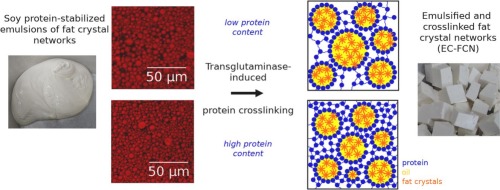当前位置:
X-MOL 学术
›
Food Hydrocoll.
›
论文详情
Our official English website, www.x-mol.net, welcomes your
feedback! (Note: you will need to create a separate account there.)
Influence of Protein Content on Plant-Based Emulsified and Crosslinked Fat Crystal Networks to Mimic Animal Fat Tissue
Food Hydrocolloids ( IF 11.0 ) Pub Date : 2020-09-01 , DOI: 10.1016/j.foodhyd.2020.105864 Johannes Dreher , Carolin Blach , Nino Terjung , Monika Gibis , Jochen Weiss
Food Hydrocolloids ( IF 11.0 ) Pub Date : 2020-09-01 , DOI: 10.1016/j.foodhyd.2020.105864 Johannes Dreher , Carolin Blach , Nino Terjung , Monika Gibis , Jochen Weiss

|
Abstract Plant-derived fats differ from animal fat tissue insofar that they do not exhibit elastic properties, but rather show a plastic behaviour upon deformation. To mimic this key property of animal fat, a system using emulsified plant derived fat crystal networks (EFCNs) embedded as droplets inside a plant protein matrix has recently been introduced. In this study the effect of protein content on the properties of the mixed network system was investigated. EFCNs were produced by hot-emulsifying mixtures of canola oil and fully hydrogenated canola oil (solid fat) at 65 °C using protein dispersions containing 5 and 11 wt% soy protein isolate (SPI). Gelation was induced by addition of transglutaminase at 37 °C, forming a covalently-linked protein network. Confocal laser scanning microscopy images revealed a decrease in mean droplet diameter at higher protein concentration. Increasing protein content, increased hardness, but also counteracted the increasingly dominating plastic behaviour at higher solid fat contents, originating from the network of fat crystals within the lipid phase. Samples manufactured with 11% SPI dispersions had higher values for cohesiveness and springiness than samples containing 5% SPI. Rheological analysis similarly showed that the limit of the linear viscoelastic region γL was found to occur at larger strains in samples with higher protein content. Taken together, results indicate that the material behaviour at a desired solid fat concentration can be tuned by variation of the protein content, which gives flexibility to manufacturers of products using the new fat system to adjust to changing processing or product requirements.
中文翻译:

蛋白质含量对模拟动物脂肪组织的植物性乳化交联脂肪晶体网络的影响
摘要 植物脂肪不同于动物脂肪组织,因为它们不表现出弹性,而是在变形时表现出塑性行为。为了模拟动物脂肪的这一关键特性,最近引入了一种使用乳化植物衍生脂肪晶体网络 (EFCN) 作为液滴嵌入植物蛋白基质内的系统。在这项研究中,研究了蛋白质含量对混合网络系统特性的影响。EFCN 是通过在 65 °C 下使用含有 5% 和 11% 的大豆分离蛋白 (SPI) 的蛋白质分散体热乳化菜籽油和完全氢化菜籽油(固体脂肪)的混合物来生产的。通过在 37°C 下添加转谷氨酰胺酶诱导凝胶化,形成共价连接的蛋白质网络。共聚焦激光扫描显微镜图像显示在较高蛋白质浓度下平均液滴直径减小。增加蛋白质含量,增加硬度,但也抵消了在较高固体脂肪含量下日益占主导地位的塑性行为,源自脂质相内的脂肪晶体网络。与含有 5% SPI 的样品相比,用 11% SPI 分散体制造的样品具有更高的内聚力和弹性值。流变学分析类似地表明,线性粘弹性区域 γL 的极限被发现出现在蛋白质含量较高的样品中的较大应变处。总之,结果表明在所需固体脂肪浓度下的材料行为可以通过蛋白质含量的变化进行调整,
更新日期:2020-09-01
中文翻译:

蛋白质含量对模拟动物脂肪组织的植物性乳化交联脂肪晶体网络的影响
摘要 植物脂肪不同于动物脂肪组织,因为它们不表现出弹性,而是在变形时表现出塑性行为。为了模拟动物脂肪的这一关键特性,最近引入了一种使用乳化植物衍生脂肪晶体网络 (EFCN) 作为液滴嵌入植物蛋白基质内的系统。在这项研究中,研究了蛋白质含量对混合网络系统特性的影响。EFCN 是通过在 65 °C 下使用含有 5% 和 11% 的大豆分离蛋白 (SPI) 的蛋白质分散体热乳化菜籽油和完全氢化菜籽油(固体脂肪)的混合物来生产的。通过在 37°C 下添加转谷氨酰胺酶诱导凝胶化,形成共价连接的蛋白质网络。共聚焦激光扫描显微镜图像显示在较高蛋白质浓度下平均液滴直径减小。增加蛋白质含量,增加硬度,但也抵消了在较高固体脂肪含量下日益占主导地位的塑性行为,源自脂质相内的脂肪晶体网络。与含有 5% SPI 的样品相比,用 11% SPI 分散体制造的样品具有更高的内聚力和弹性值。流变学分析类似地表明,线性粘弹性区域 γL 的极限被发现出现在蛋白质含量较高的样品中的较大应变处。总之,结果表明在所需固体脂肪浓度下的材料行为可以通过蛋白质含量的变化进行调整,









































 京公网安备 11010802027423号
京公网安备 11010802027423号